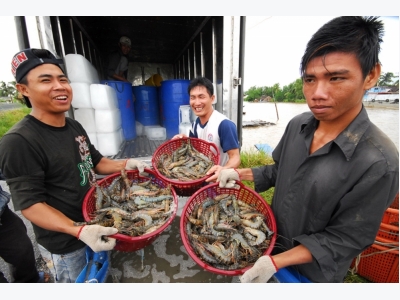Farming pegged as export promise of 2018

In addition to improving quality, promoting branding and expanding export markets, the agricultural sector will strive to earn roughly US$40 billion from exports this year.
The fishery sector is forecast to continue to grow in 2018
The previous year began with a series of pessimistic forecasts on exports of agriculture, forestry and fishery products due to extreme weather, epidemics and difficulties in the export markets. However, intense government efforts helped defy the gloomy predictions and achieve positive results. As a result, Vietnam’s agriculture and fishery export revenues reached a record high of US$36.37 billion in 2017, up 13 percent from the previous year.
In 2017, reflecting the great importance he attributes to agricultural development, Prime Minister Nguyen Xuan Phuc chaired five major agricultural conferences. The subjects ranged from organic farming to high-quality rice production, shrimp production and sustainable development of the Mekong Delta. Attending a conference on shrimp production held in the southernmost province of Ca Mau in early February 2017, the prime minister issued a series of short-term and long-term tasks and urged the shrimp industry to more than double exports to US$10 billion by 2025.
The shrimp industry created a breakthrough in 2017. After a slight decrease in the first quarter, shrimp exports saw strong growth, reaching an estimated US$3.8 billion for the year, an increase of 20 percent compared to the previous year.
With strong development of shrimp exports, 2017 saw the highest ever growth in fishery export revenues with over US$8.3 billion, up nearly US$1 billion compared to 2016. It was also a winning year for many other agricultural products, such as fruits and vegetables (more than US$3.5 billion) and cashew nuts (US$3.5 billion).
The positive results of exports of agriculture, forestry and fishery products in 2017 will be the driving force for the agricultural sector to earn roughly US$40 billion from exports in 2018.
Le Van Quang, board chairman of the Minh Phu Seafood Joint Stock Company, said there are many favorable conditions for the fishery sector to reach impressive growth in 2018. With new technologies for higher productivity and profits, farmers are encouraged to promote investment in aquaculture.
Nguyen Thi Anh, director of the Song Tien Seafood Corporation, said tra fish exports to some European countries continue to grow at the beginning of 2018. She hopes the corporation’s fishery exports would expand by 10 percent this year compared to the previous year.
In terms of agricultural products, fruit and vegetable exports will continue to grow. However, to ensure sustainable development, businesses must improve their fruit and vegetable quality.
Rice also reached US$2.6 billion in export turnover in 2017. This result was partly due to the continuous efforts of exporters to sell the products that the market needs. The structure of export rice in the past year saw a positive shift. In 2018, the world rice market will be more active. According to the US Department of Agriculture, global rice trade will continue to grow by one percent to 42.3 million tonnes in 2018.
Pham Thai Binh, director of the Can Tho City-based Trung An Hi-Tech Farming Joint Stock Company, said that due to good indicators in terms of market and commercial value, the company will produce 150,000 tonnes of rice for exports in 2018.
However, Pham Thai Binh also said the Vietnamese rice sector is still less competitive because it lacks sufficient state support, which is needed to help the rice sector create a breakthrough.
Có thể bạn quan tâm
 Vietnam shrimp exports to touch USD 3.8 billion
Vietnam shrimp exports to touch USD 3.8 billion Exports of whiteleg shrimp occupied the largest proportion of 65.4%; those of black tiger shrimp accounted for 23%, the rest was marine shrimp with 11.6%
 Vietnam’s seafood exports to EU see positive changes
Vietnam’s seafood exports to EU see positive changes The exports of octopus and squid also recovered strongly last month, contributing to year-on-year growth of 5% in the total octopus and squid export turnover.
 Aquaponics: ‘economy of scale is the key’
Aquaponics: ‘economy of scale is the key’ Aquaponics, which combines aquaculture and hydroponics, is increasingly becoming popular in many countries due to its ability to boost farm output